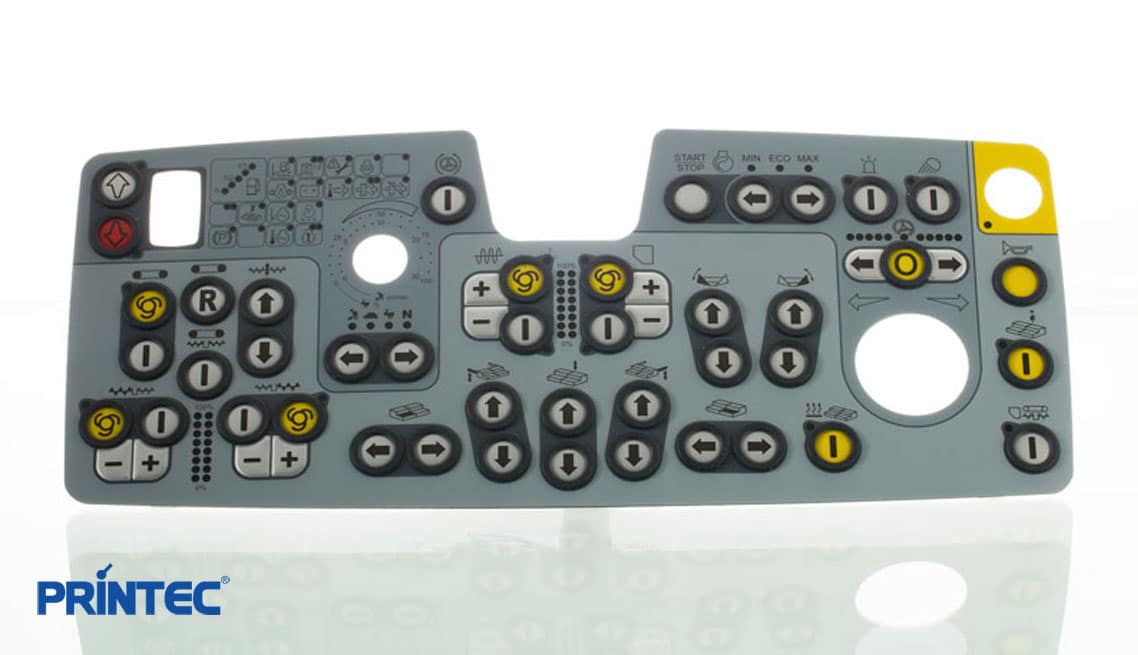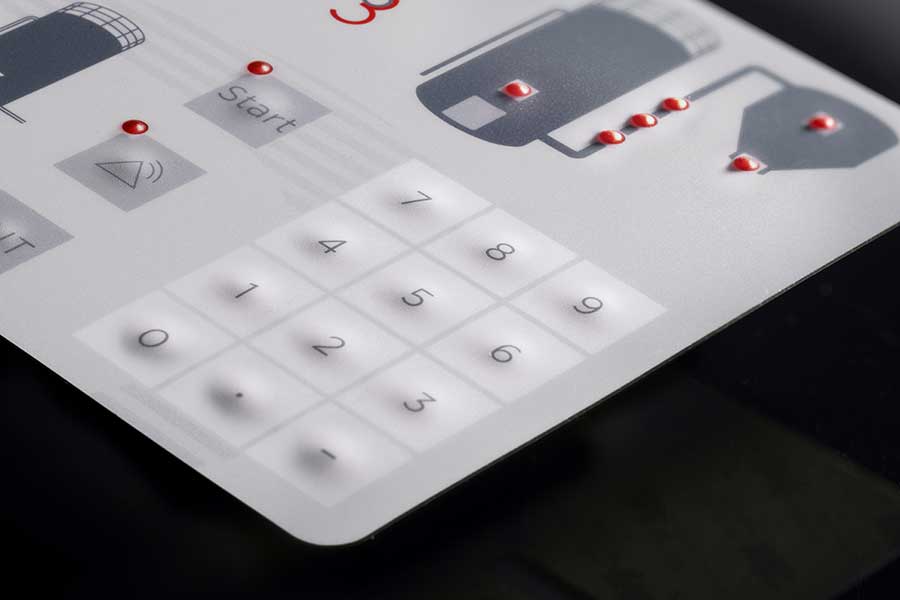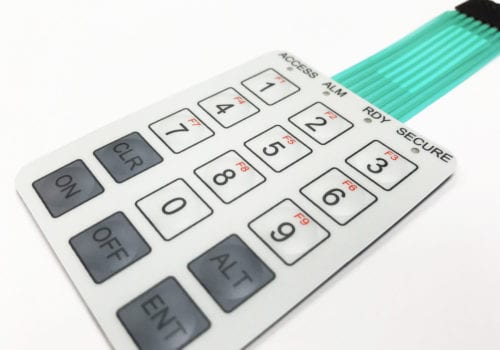Every well-executed product line begins with choosing the right membrane switch manufacturer early on.
Every well-executed product line begins with choosing the right membrane switch manufacturer early on.
Blog Article
Everything About Membrane Layer Switch Over: Recognizing Its Style and Performance
When you believe about the control interfaces in modern devices, membrane switches typically come to mind. Allow's discover what sets membrane changes apart from various other control systems.
What Are Membrane Buttons?

Their smooth nature makes them simple to clean and immune to dust and dampness, a crucial function in many settings. Membrane switches can additionally be customized regarding shape, dimension, and graphics, enabling makers to develop one-of-a-kind user interfaces customized to particular items. Plus, they're lightweight and slim, which aids in lessening the overall bulk of tools. On the whole, membrane switches play a significant function in improving user experience throughout a large range of applications.
Just How Membrane Switches Over Job
When you press a key on a membrane layer switch, it activates an uncomplicated yet effective device. The leading layer, typically made of adaptable product, lowers onto a conductive layer underneath it. This activity bridges the void between conductive traces, completing an electric circuit. As quickly as the circuit closes, it sends a signal to the gadget's controller, which interprets your input.
You'll see that the tactile responses varies based upon the button style, supplying either a soft click or a much more noticable reaction. When you launch the secret, the membrane layer returns to its original position, reopening the circuit and stopping the signal. This procedure occurs almost instantaneously, guaranteeing a responsive individual experience.
Membrane layer switches are prominent because of their toughness and resistance to dust and dampness, making them excellent for different applications, from house devices to clinical tools. Understanding this operation assists you value their widespread use.
Secret Elements of Membrane Layer Switches
Comprehending the key parts of membrane layer switches is essential for realizing their capability and design. The safety layer shields against environmental variables and use, extending the switch's lifespan. By understanding these elements, you'll obtain understanding right into just how membrane switches over run and their significance in various applications.
Products Used in Membrane Layer Switch Style
The performance and sturdiness of membrane layer changes greatly rely on the materials made use of in their design. You usually come across polyester and polycarbonate as primary substratums as a result of their outstanding toughness and versatility. These materials resist scratches and chemicals, making them perfect for requiring settings.
The conductive layers usually use silver or carbon, picked for their reliability and conductivity. membrane switch manufacturer. Silver offers remarkable efficiency, while carbon is a cost-efficient option. For the overlay, you might consider a matte or glossy finish, depending on your visual demands and user experience
Adhesives play a vital function also; they bond layers securely and guarantee durability. Ensure to select adhesives that hold up against ecological elements like temperature level and humidity. Do not ignore the importance of a good printing method for graphics, as it improves both functionality and aesthetic allure. Choosing the right materials will certainly assure your membrane layer button stands the examination of time.
Layout Factors To Consider for Membrane Layer Buttons
While making membrane layer buttons, it's vital to take into consideration various variables that affect their capability and user experience. Begin by focusing on the layout and switch size; make sure they're user-friendly and simple to navigate. Consider the responsive responses you intend to give-- will customers require a visible click or a softer touch? In addition, think of the products you'll utilize, as they'll affect sturdiness and visual appeals.
Don't neglect the visuals style; clear labeling and shade contrast are considerable for exposure. Verify your design fits environmental aspects, like moisture or temperature level variants, which could impact efficiency. Bear in mind the relevance of screening prototypes with actual users to gather comments and make necessary modifications. This iterative procedure aids you refine the style, confirming it fulfills both practical and visual needs effectively. By carefully taking into consideration these components, you'll develop a membrane switch that boosts usability and contentment.
Applications of Membrane Buttons
Membrane layer buttons are functional components found in numerous applications, from commercial devices to consumer electronic devices. You'll see their effect in makers that require resilient interfaces and in tools that profit from streamlined layouts. Understanding these applications assists you appreciate the capability and practicality of membrane layer switches in everyday modern technology.
Industrial Devices Use
When you're aiming to enhance the capability of commercial equipment, membrane layer switches use a reputable solution his response that integrates durability with easy to use style. These buttons are best for harsh atmospheres, offering resistance to dirt, wetness, and chemicals. You'll find them in control panels for manufacturing equipments, heating and cooling systems, and medical devices, where accuracy and responsiveness are vital. Their reduced account means they fit effortlessly right into numerous devices, saving beneficial room while maintaining convenience of use. With personalized graphics and backlighting alternatives, you can develop an intuitive user interface for drivers, enhancing efficiency and safety. And also, their lengthy life-span minimizes upkeep prices, making them a smart investment for your industrial applications. Embrace membrane switches to simplify your procedures and boost general efficiency.
Consumer Electronics Integration
In the domain name of consumer electronic devices, membrane switches play a vital role in enhancing user interaction and tool functionality. You'll locate them in devices like microwaves, push-button controls, and gaming consoles, supplying a smooth method to communicate with technology. Their smooth layout permits for simple assimilation into different products, making controls instinctive and straightforward. With their ability to include graphics and backlighting, you can delight in a modern-day aesthetic that complements the tool's general appearance. Membrane buttons additionally ensure durability and resistance to dust and dampness, extending the life-span of your electronic devices. By selecting membrane layer switches, you improve not just the functionality yet also the style of your devices, making day-to-day communications smooth and delightful.
Benefits and Negative Aspects of Membrane Layer Buttons
While membrane switches provide a range of advantages, why not try this out they also come with some drawbacks that you need to take into consideration. One substantial advantage is their compact design, making them suitable for space-constrained applications.

Membrane switches can have a much shorter life expectancy compared to mechanical switches, particularly under hefty usage. They can likewise be much less responsive, which could impact individual responses throughout operation. Balancing these pros and cons will certainly assist you figure out if membrane layer buttons are the appropriate fit for your project.
Often Asked Concerns
For How Long Do Membrane Switches Commonly Last?
Membrane switches over normally last in between 5 to 10 years, depending on use and environmental problems. You'll desire to review aspects like wear, exposure to dampness, and temperature level variations to evaluate their durability efficiently.
Can Membrane Changes Be Customized for Certain Layouts?
Yes, you can personalize membrane layer buttons to fit particular designs (membrane switch manufacturer). You'll have the flexibility to pick shades, forms, and designs that match your task's demands, ensuring they blend perfectly with your total visual
What Is the Expense Array for Membrane Change Manufacturing?
The price array for membrane layer button manufacturing typically drops between $1 and $10 per device, depending on factors like style complexity, quantity, and materials. You can obtain quotes from producers to locate the ideal alternative.

Are Membrane Changes Water Resistant or Resistant?
Membrane switches can be designed to be waterproof or resistant, relying on products used and construction techniques. If you require them for damp atmospheres, guarantee you specify those requirements throughout the style process.
Just How Do Membrane Changes Contrast to Standard Buttons?
Membrane switches are normally thinner and more flexible than typical switches, supplying a streamlined layout. They're frequently much easier to clean up and integrate, however could not offer the tactile comments you're made use of to with mechanical options.
Final thought

Report this page